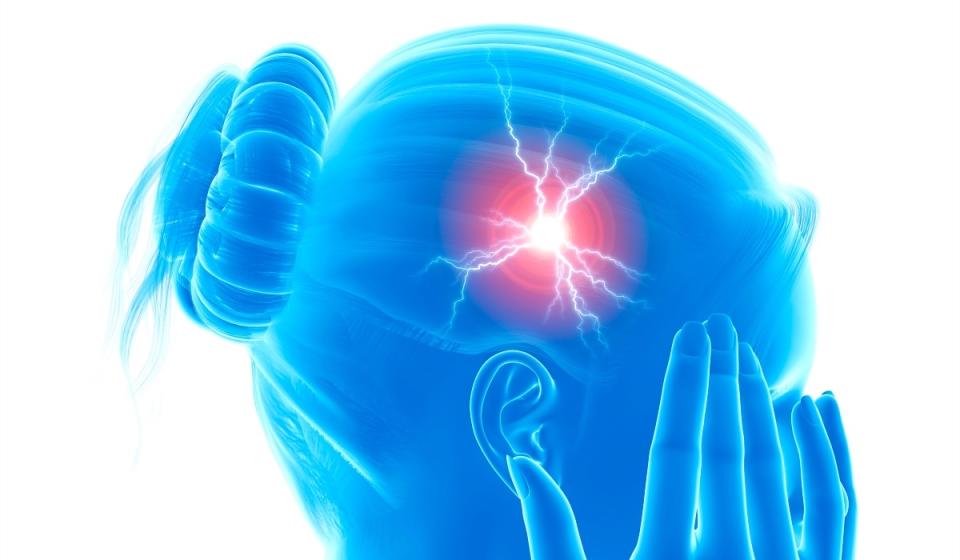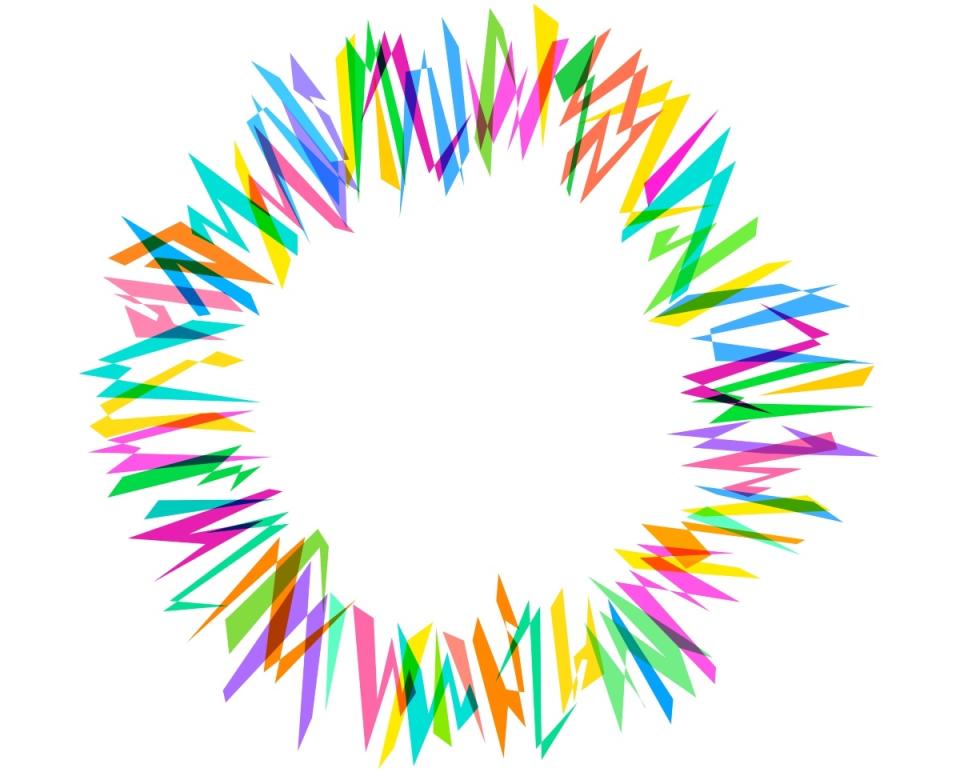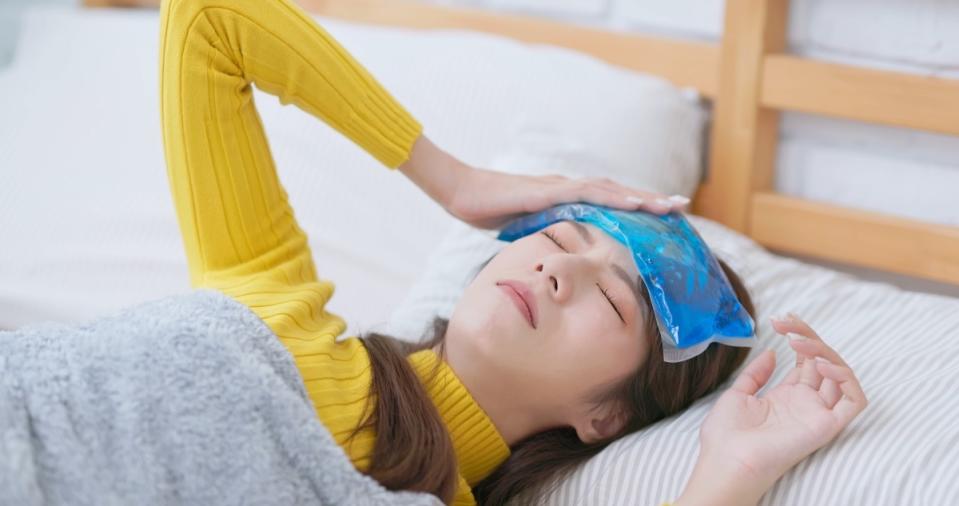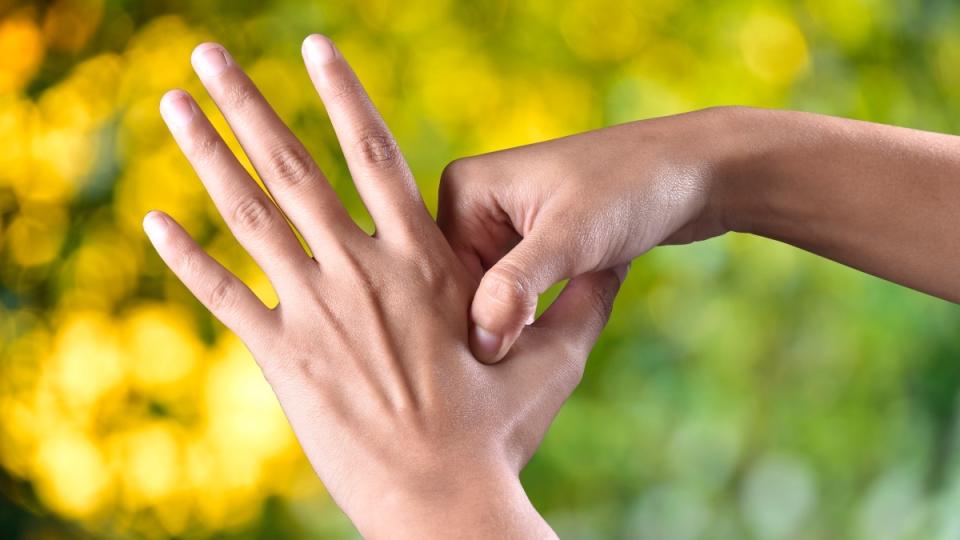Study: Ginger Tea Can Relieve Migraine Pain + 3 Other Migraine Self-Care Strategies That MDs Recommend
If you suffer from migraines, you know that this type of splitting headache can leave you down for the count for hours or even days. And when one strikes, you want to do whatever you can to soothe away the pain and speed your recovery. The good news: There are simple strategies that can alleviate discomfort even once your migraine has become full-blown. Here, discover the latest science on migraines, why you might be prone them and the best migraine self-care strategies to soothe the hurt — and outsmart migraines from being triggered in the future.
What are migraines?
Migraines are moderate to severe throbbing headaches that typically occur on one side of the head. Often, they're accompanied by sensitivity to light and sound, nausea and/or vomiting, explains Nicholas Tzikas, MD, a neurologist with Yale Medicine and an assistant professor of clinical neurology at Yale School of Medicine in New Haven, CT. “The pain can also switch sides, migrate or involve the entire head," he notes. "Left untreated, migraines can last anywhere between four to 72 hours.”
If you’re prone to migraines, you’ve got plenty of company. In fact, 28 million American women suffer through these debilitating headaches, according to the American Headache Society. And while you might think of a migraine as a more severe headache, migraines are actually a type of neurological disorder and a disruption of the nervous system. The pain and sensory sensitivity happens when there’s an external or internal trigger that causes brain neurons to fire abnormally.

Migraine warning signs
A migraine can send you specific signs it’s on its way. “Migraines have various phases, but the two which typically precede a migraine are the prodromal phase and aura," says Dr. Tzikas. "The prodromal phase can kick in hours or days prior to a migraine, warning of an impending attack. Signs and symptoms of the prodromal phase include excessive yawning, concentration difficulties, irritability, and gastrointestinal disturbances, among others."
The aura phase, on the other hand, can temporarily cause visual disruptions such as seeing "stars", zig-zags or sparks in your vision. It can also trigger numbness or tingling in the body. This phase typically lasts five to 60 minutes, the American Migraine Foundation reports.

Types of migraines
It's important to know you can experience a migraine headache following the prodromal or aura phase, or you can get a migraine and aura symptoms simultaneously. When the two occur at the same time, it's known as a migraine with aura, or a "classic migraine".
The most common type of migraines however, are those that occur without symptoms of aura. This migraine is known as a migraine without aura, or a "common migraine". About 75% of people with migraines don’t experience aura, reports the National Institutes of Health.
Finally, though uncommon, you can also experience an aura without a migraine headache — this affects only about 4% of people who get migraines.
The most common migraine triggers
There are many different things that can bring on a migraine, but the two most common triggers in women are hormonal changes and stress, explains headache specialist Susan Hutchinson, MD, a board-certified family practice physician, director of the Orange County Migraine and Headache Center in Irvine, CA, and author of The Women's Guide to Managing Migraine.
1. Hormone changes
Estrogen changes throughout a woman’s lifetime, whether during menstruation or perimenopause (when your body begins to transition into menopause), can increase the risk of having a migraine and make them more severe. “During perimenopause, there’s an increase in migraines due to widely fluctuating estrogen levels," Dr. Hutchinson explains. "But once a woman is post-menopausal, there can be improvement, since hormones are no longer fluctuating. Studies have shown that keeping estrogen (estradiol) levels steady can help prevent hormonally triggered migraines."
Dr. Tzikas agrees there’s a strong connection between hormones and migraines. “Many women will note they get migraines around the time of their menstrual cycle as estrogen levels drop. In line with that connection, many women have noted an improvement in their migraines during pregnancy when estrogen levels rise,” he says. (Menopause can cause more than just migraines. Click through to see the link between menopause and irritability and how menopause raises the risk of bladder trouble known as interstitial cystitis.)
2. Stress
The American Migraine Foundation found that everyday stress is a trigger for up to 70% of migraines. “There are multiple reasons stress can aggravate or trigger a migraine, including anxiety, insomnia, poor eating habits and other factors that often co-exist with stress,” says Dr. Hutchinson.
One way stress may bring on migraine pain is by spurring the release of certain hormones. When you’re experiencing a stressful event, your body releases the stress hormone cortisol as well as adrenaline, responsible for your "fight or flight" response. In increased amounts, these hormones can spark vascular changes (such as constricting blood vessels in the brain) to bring on a migraine headache. Worry, anxiety, and fear can also create muscle tension, potentially making a migraine more severe. (Click through to learn how many hugs we need a day to ease stress.)

3. Lifestyle changes
Dr. Hutchinson says other migraine triggers can come from food, lifestyle factors and our environment. She notes that foods with certain preservatives, artificial sweeteners or monosodium glutamate (MSG), alcoholic beverages, and drinking too much caffeine can all bring on a migraine. Inadequate sleep as well as changes in barometric pressure can also contribute to a migraine attack.
4. Genetics
If you suffer from migraines, you may have your genes to blame, too. “Migraines have a tendency to run in families,” says Dr. Tzikas. “Heredity can count for up to 50% of a person’s susceptibility to migraine. And one study found the risk of migraine in patients who had relatives with migraine was three times greater than that of people who didn’t have a family history of migraine.”
Prescription treatments for migraines
Your doctor has a wide range of prescription medications that can help shorten the duration of pain you feel from a migraine. These include a class of drugs called Triptans (which include sumatriptan and rizatriptan) and a class of drugs called Ergotamines (like ergotamine tartrate and dihydroeergotamine) in combination with caffeine. Your doctor may also suggest antinausea medications to help with nausea or vomiting. In addition, some doctors recommend beta blockers, calcium channel blockers, antidepressants or antiseizure medications as a preventative measure. There's also a newer class of drugs specifically designed for migraine prevention known as Calcitonin gene-regulated peptide (CGRP) inhibitors, which includes erenumab and galcanezumab.
The best natural migraine self-care remedies
Prescription medications aren't right for everyone — and they rarely eliminate all the symptoms of a migraine — and that's why knowing a few self-care approaches is crucial to anyone who frequently suffers from migraines. Here, the best migraine self-care tips to get you through the thick of it.
1. Migraine self-care remedy: Apply a cold pack
Just as you’d nurse a sore knee with an ice pack, you can do the same for migraine pain. Lie back and apply an ice pack (a bag of frozen peas will do!) or a cold compress to your temples and scalp. Cooling this area constricts blood vessels and tames inflammation, plus it has a numbing effect to dull the discomfort.
The simple trick is so effective that a study in Evidence-Based Complementary and Alternative Medicine found applying a cold pack to the forehead for 25 minutes at the first sign of a migraine reduces pain by 30%. Plus, 12% of folks in the study were able to stop their burgeoning migraine completely and did not need to take a pain-relieving medication. In other research, scientists noted a 31% reduction in migraine pain when the cold pack used was wrapped around the neck. What's more, a separate study found cold packs placed on the temple were effective at curbing migraine pain in 71% of people. (The benefits of cold therapy don't stop there. Click through to learn how cold water tones the vagus nerve to reverse the chronic stress that can trigger migraines.)

2. Migraine self-care remedy: Find a dark, quiet place
Light and sound can make migraine pain worse. If you can, close the door to your bedroom and draw the shades, then lie down for about 20 to 30 minutes for a little migraine self-care break. “A dark, quiet room decreases the external stimuli of bright light and noise that could either be aggravating the migraine attack or be the actual initial trigger for the attack,” explains Dr. Hutchison. Blocking out additional stimuli "helps to 'calm' the hypersensitive nervous system and can also be a relaxing experience. As soon someone feels a migraine coming on, they should try to decrease external stimuli. This, in turn, can shorten the duration and/or lessen the severity of the migraine attack.” (Click through for more easy, natural ways to regulate your nervous system.)
If you find yourself unable to retreat to a dark, quiet room, try donning a pair of sunglasses or rose-hued glasses. Lenses tinted with FL-41, a rose-colored hue, helps filter out specific types of light that can trigger migraine, such as fluorescent, blue or green light. And wearing the rose-tinted glasses regularly can help thwart future attacks, too. One study in Headache found folks who wore the glasses for 4 months experienced up to 74% fewer migraines per month. One to try: Terramed Migraine Glasses FL-41 (Buy from Amazon, $69.99).
3. Migraine self-care remedy: Press this spot
Another strategy you can use whether your tucked in at home when the migraine strikes or out and about is an acupressure move. To do: Use your thumb or (a pencil eraser) to apply pressure to the LI-4 spot on your opposite hand. You can find it in the fleshy space between the base of your thumb and index finger on the top of your hand. Press down on this point and firmly massage in a clockwise fashion, then reverse, for 2 to 3 minutes.
Research published in in Evidence-Based Complementary and Alternative Medicine found pressing on the LI-4 spot can help alleviate nerve inflammation, inhibit pain-activated regions in the brain, and provide pain-relieving effects.

4. Migraine self-care remedy: Sip ginger tea
Ginger tea has long been used in Traditional Chinese Medicine to ease headaches. Now, a study in Phytotherapy Research found the spice reversed a burgeoning migraine as effectively as the migraine medication sumatriptan. Plus, ginger didn’t come with some of the medicine’s side effects such as dizziness, heartburn, or drowsiness. To make your own healing brew, steep 1" of sliced fresh ginger or 1⁄4 tsp. of ground ginger in 8 oz. of hot water for 5 to 10 minutes. Add lemon or honey for taste, if desired, then enjoy. (Click through to discover how to make ginger cinnamon tea for migraines.)

Tip: You can also apply ginger oil directly to painful areas as a soothing migraine self-care remedy, recommends Dr. Tzikas. “According to some studies, diluted ginger oil massaged into your temples and neck can alleviate pain, and the aroma may help with nausea,” he notes. Simply add a few drops of ginger oil to a small amount of carrier oil, such as coconut oil or almond oil, then massage the mixture into your temples or neck at the base of your skull using firm, circular motions.
4 ways to ward off future migraines
While migraine self-care tips can help you deal with pain in the moment, odds are you want to curb your risk of ever having a migraine in the first place. These smart moves can help:
1. Sip 8 glasses of water a day
If you're like us, busy days can make it hard to remember to sip enough water when you've got so many other things on your plate. But even mild dehydration can raise your risk of future migraine attacks. A study in the Journal of Clinical Neuroscience found that when women who suffered from migraines drank about 8 glasses of water a day, they had a significant reduction in the severity, duration and frequency of their migraines over a month’s time.
Why? When you’re lacking adequate fluids, your brain and other tissues in your body contract. And as your brain shrinks, it pulls from the skull, puts pressure on the nerves, and causes pain, But, when you consume water and other fluids, the contraction stops and the pain disappears. (Need a reminder to up your intake? Click through to see how a motivational water bottle can help.)
2. Do a simple yoga routine 5 days a week
Turns out enjoying some relaxing yoga poses and stretches can ward off future migraine attacks. Research in the International Journal of Yoga found that practicing yoga regularly (about 5 days a week) can significantly reduce the frequency and intensity of migraines. Yoga helps prevent migraines by relieving tension and anxiety, improving circulation, and increasing healing blood flow to the brain. Interested in giving it a try? Check out the migraine-easing poses in the video below. (Click through to learn how chair yoga for seniors can tame chronic pain.)
3. Track your triggers over time
A headache journal can help you pinpoint what might be causing or contributing to your migraines. “Start keeping a diary or headache journal to track what seems to appear hours or day before migraine,” says Dr. Hutchinson. For example, if you notice you get migraines after you eat certain foods, don’t get enough sleep, or are under a lot of stress, this can provide valuable clues you need to make any dietary or lifestyle changes. “Once you start figuring out what your triggers are, you can try and prevent them. For example, if you get a migraine every Sunday evening, it may indicate the problem has to do with the job you’re going to on Monday,” she adds.

4. Start journaling
Aside from tracking your symptoms, journaling can also be a helpful tool in easing stress, says Dr. Hutchinson. The key: Using a type of journaling known as expressive writing, especially if you suspect your migraines might be triggered by emotional stress. In this practice, you spend about 20 minutes daily writing about your thoughts, worries and feelings. “Women have so much stress in their lives, so it’s vital they take time to de-stress,” says Mark Menolascino, MD, author of Heart Solution for Women.
Getting your emotions down on paper can be cathartic, allowing you a safe place to vent and release pent-up tension. And research proves it works. A study in JMIR Mental Health suggests journaling can decrease anxiety, a top migraine trigger. And Yale-trained physician Aviva Romm, MD, says writing down one thing you did each day that made you feel good about yourself can boost the benefit even further. “Optimism and gratitude release hormones that counteract the stress response and rewire the brain,” she says. (Click through for journal prompts to tame stress.)
Migraine journaling success story: Anna Holtzman, 47

Closing her office door, Anna Holtzman, 47, shut off the lights and stretched out on the floor. She prayed the pain medicine she took to dull the intense throbbing in her head would kick in fast. Having a coworker — or her boss — find her this way would be too embarrassing. But when a migraine took hold, this was Anna’s only hope of getting relief.
Anna’s migraines began 10 years ago as a once-in-a-while occurrence, striking once a month or so. But as the stress of working a high-pressure job as a video editor in reality TV grew, so did the frequency of her migraines. Soon, they were striking 1 to 3 times a week. Along with excruciating pain, she’d experience intense nausea and dizziness.
When she left her job and enrolled in grad school to fulfill her dream of becoming a therapist, Anna hoped her migraines would ease. But they continued to grow in intensity and frequency to the point where she was running out of her prescription painkillers each month.
Anna tried everything she could to stave off a migraine. She made sure to eat and drink water on a regular schedule and avoided triggers like bright lights and loud noises. I don’t know what more I can do, she despaired.
What Anna learned about the mind-body connection
Then, one day, while searching online, Anna came across an app called Curable. The program offers users audio lessons on pain science and teaches them how to apply a wide range of science backed techniques to reduce symptoms. Experimenting with an app wasn’t something Anna would have normally thought helpful, but she was desperate.
Using the app’s free trial, Anna learned pain is a danger signal that’s created in the brain when our nervous system feels unsafe. Sometimes, the danger is physical (like a broken arm), sometimes, it’s emotional (like a stressful relationship) and sometimes, it’s a learned association (similar to a trauma trigger). But regardless of the cause, the nervous system needs to feel safe to turn off that pain signal.
The app’s team of experts offered several techniques to help achieve a sense of safety, including cognitive behavioral therapy, guided meditation and visualization. But Anna was most intrigued by something called JournalSpeak, a form of expressive writing.
How journaling finally freed Anna from migraine pain
Developed by Nicole Sachs, LCSW, JournalSpeak involves spilling out your raw, unfiltered emotions on the page for 20 minutes every day. Anna dove in head-first. As the pages of her journal filled with her unprocessed feelings of frustration, sadness and anger, she was amazed to find her headache pain lessened and her nausea and dizziness were less frequent.
Anna learned our emotions are like people: They all have something to say, and if we don’t listen to them, they may eventually throw a tantrum in the form of physical symptoms to get our attention.
“My emotions threw a fit that manifested in migraines. But as I practiced daily journaling, the headache pain and other symptoms continued to improve. And after a year of daily writing, my migraines have become a rarity,” Anna happily reports. “It’s wonderful. I no longer live with the desperation, and even isolation, of life with chronic migraines. Journaling has been a game changer!”
For more ways to outsmart migraine pain:
10 Migraine Supplements to Relieve Debilitating Pain
This Warming Spiced Tea Helps Fight Inflammation and Ease Migraine Pain
5 Soothing Herbal Teas to Nix Headaches and Migraines
This content is not a substitute for professional medical advice or diagnosis. Always consult your physician before pursuing any treatment plan.
Woman's World aims to feature only the best products and services. We update when possible, but deals expire and prices can change. If you buy something via one of our links, we may earn a commission.
Questions? Reach us at shop@womansworld.com

